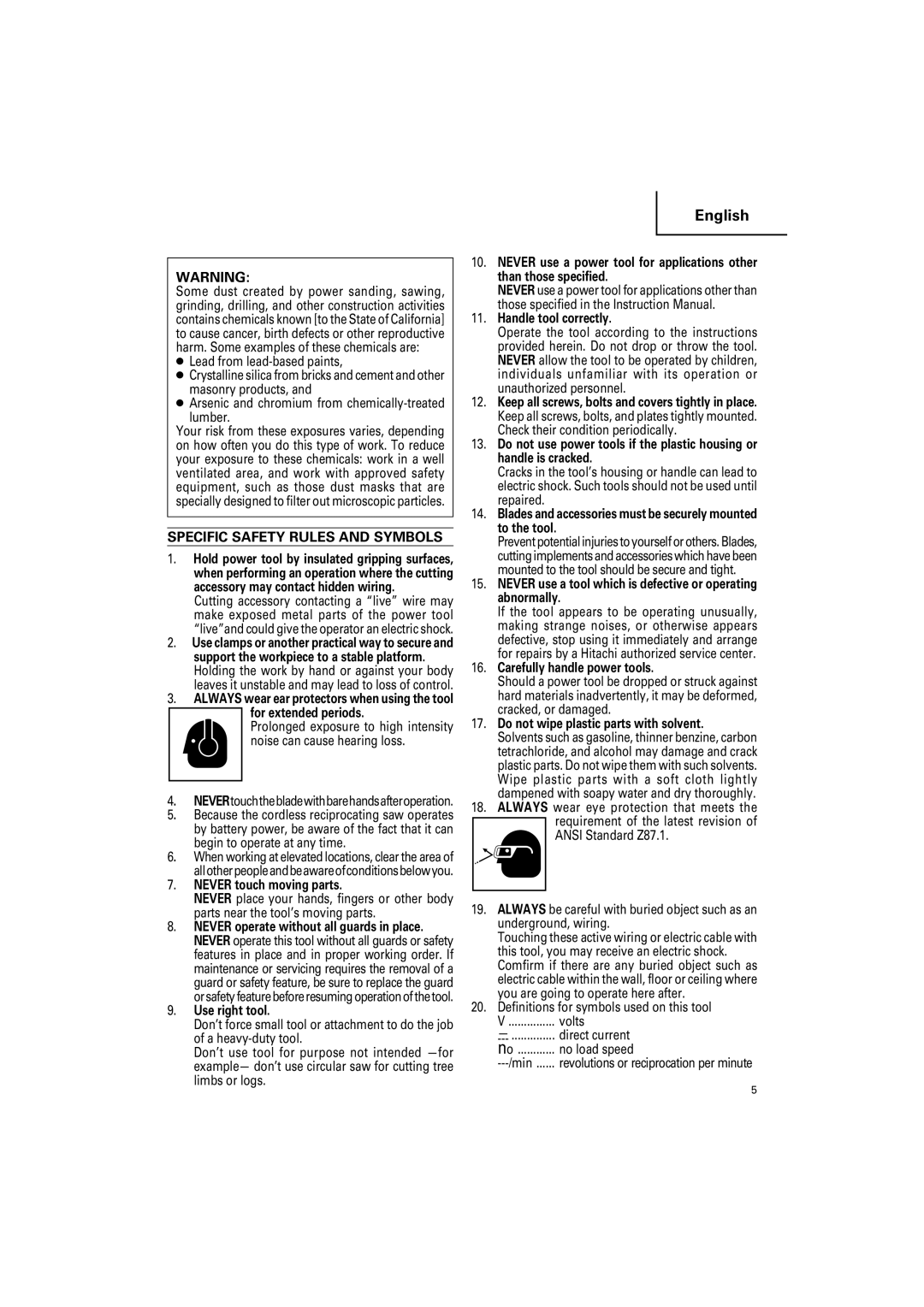
English
WARNING:
Some dust created by power sanding, sawing, grinding, drilling, and other construction activities contains chemicals known [to the State of California] to cause cancer, birth defects or other reproductive harm. Some examples of these chemicals are:
●Lead from
●Crystalline silica from bricks and cement and other masonry products, and
●Arsenic and chromium from chemically-treated lumber.
Your risk from these exposures varies, depending on how often you do this type of work. To reduce your exposure to these chemicals: work in a well ventilated area, and work with approved safety equipment, such as those dust masks that are specially designed to filter out microscopic particles.
SPECIFIC SAFETY RULES AND SYMBOLS
1.Hold power tool by insulated gripping surfaces, when performing an operation where the cutting accessory may contact hidden wiring.
Cutting accessory contacting a “live” wire may make exposed metal parts of the power tool “live”and could give the operator an electric shock.
2.Use clamps or another practical way to secure and support the workpiece to a stable platform. Holding the work by hand or against your body leaves it unstable and may lead to loss of control.
3.ALWAYS wear ear protectors when using the tool for extended periods.
Prolonged exposure to high intensity noise can cause hearing loss.
4. NEVERtouchthebladewithbarehandsafteroperation.
5. Because the cordless reciprocating saw operates by battery power, be aware of the fact that it can begin to operate at any time.
6. When working at elevated locations, clear the area of allotherpeopleandbeawareofconditionsbelowyou.
7.NEVER touch moving parts.
NEVER place your hands, fingers or other body parts near the tool’s moving parts.
8.NEVER operate without all guards in place. NEVER operate this tool without all guards or safety features in place and in proper working order. If maintenance or servicing requires the removal of a guard or safety feature, be sure to replace the guard orsafetyfeaturebeforeresumingoperationofthetool.
9.Use right tool.
Don’t force small tool or attachment to do the job of a
Don’t use tool for purpose not intended
10.NEVER use a power tool for applications other than those specified.
NEVER use a power tool for applications other than those specified in the Instruction Manual.
11.Handle tool correctly.
Operate the tool according to the instructions provided herein. Do not drop or throw the tool. NEVER allow the tool to be operated by children, individuals unfamiliar with its operation or unauthorized personnel.
12.Keep all screws, bolts and covers tightly in place. Keep all screws, bolts, and plates tightly mounted. Check their condition periodically.
13.Do not use power tools if the plastic housing or handle is cracked.
Cracks in the tool’s housing or handle can lead to electric shock. Such tools should not be used until repaired.
14.Blades and accessories must be securely mounted to the tool.
Prevent potential injuries to yourself or others. Blades, cutting implements and accessories which have been mounted to the tool should be secure and tight.
15.NEVER use a tool which is defective or operating abnormally.
If the tool appears to be operating unusually, making strange noises, or otherwise appears defective, stop using it immediately and arrange for repairs by a Hitachi authorized service center.
16.Carefully handle power tools.
Should a power tool be dropped or struck against hard materials inadvertently, it may be deformed, cracked, or damaged.
17.Do not wipe plastic parts with solvent.
Solvents such as gasoline, thinner benzine, carbon tetrachloride, and alcohol may damage and crack plastic parts. Do not wipe them with such solvents. Wipe plastic parts with a soft cloth lightly dampened with soapy water and dry thoroughly.
18.ALWAYS wear eye protection that meets the requirement of the latest revision of ANSI Standard Z87.1.
19.ALWAYS be careful with buried object such as an underground, wiring.
Touching these active wiring or electric cable with this tool, you may receive an electric shock. Comfirm if there are any buried object such as electric cable within the wall, floor or ceiling where you are going to operate here after.
20.Definitions for symbols used on this tool V ............... volts
— | direct current |
no | no load speed |
revolutions or reciprocation per minute |
5
